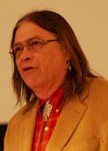I’ve praised the movie “New World” in this blog for its attention to historical authenticity, and readers of this blog have debated the merits of revisionist history. Now comes an article from the William & Mary website about the behind-the-scenes interaction between Virginian Indians and “New World” director Terence Malick over the portrayal of Indian culture in the movie.
Quotable quote:
When leaders of Virginia’s Indian communities were first asked to consult on the film, many of them were hesitant because they realized that any story that focused on Capt. John Smith and his relationship with Pocahontas—a story most First Americans do not accept—was apt to present a distorted image of the Virginia Algonquian heritage, Green said. He, however, was anxious to participate.
“My idea was that you don’t see too many movies about Virginia Indians,” he explained, “so maybe we can take this situation and educate the public. Maybe we can show them that we are still here.”
Overall, though, the movie-making experience was a positive one.
(Photo credit of chief Robert Green of the Patawomeck tribe: William & Mary.)


Leave a Reply
You must be logged in to post a comment.